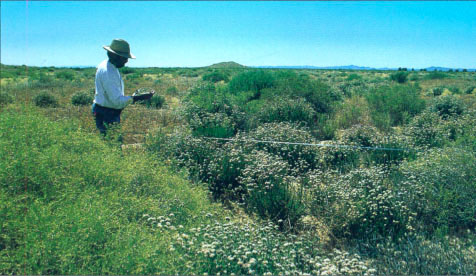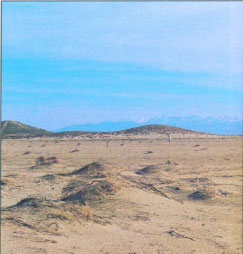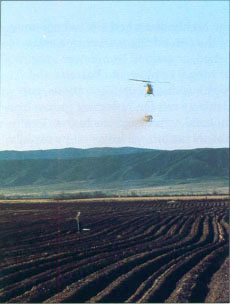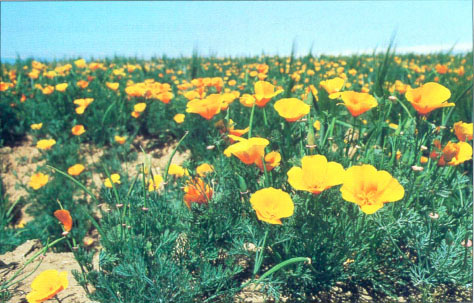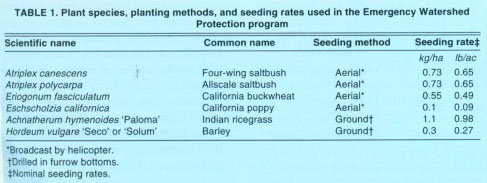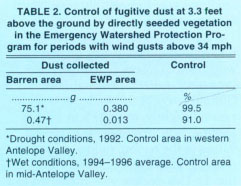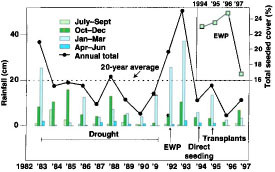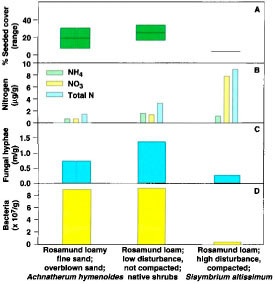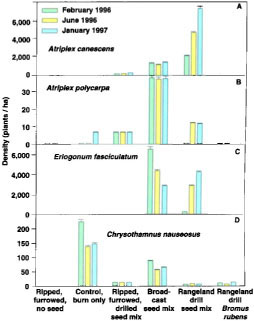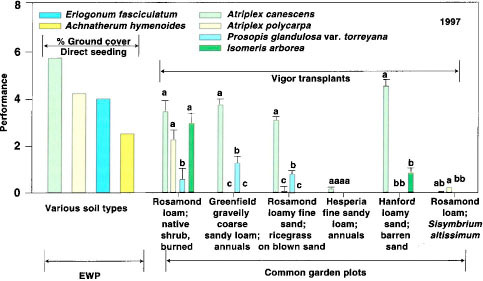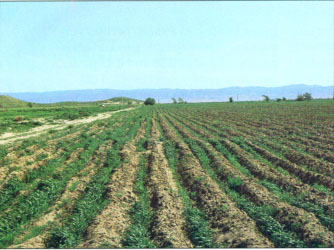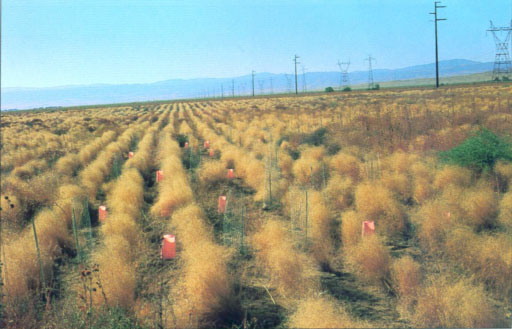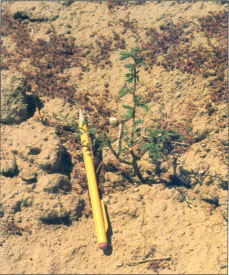All Issues
DustBusters reduce pollution, wind erosion: Though difficult to achieve, revegetation is best way to stabilize soil
Publication Information
California Agriculture 52(4):8-13. https://doi.org/10.3733/ca.v052n04p8
Published July 01, 1998
PDF | Citation | Permissions
Abstract
Surface disturbance in arid regions — whether it results from abandoned agriculture, overgrazing or recreational activities — often sets the stage for windblown fugitive dust. Revegetation provides the most sustainable soil stabilization but is difficult to achieve in any given year. Widely varying environmental conditions and soil factors make direct seeding unreliable, and transplanting of nursery-grown shrubs does not assure plant establishment, even with supplemental irrigation. In occasional years plants can be successfully established, particularly Atriplex canescens, in the western Mojave Desert. Once vegetation becomes established, it successfully stabilizes the soil surface and reduces blowing dust. However, because successful establishment is infrequent, reliable mitigation of fugitive dust requires that other techniques be used as well.
Full text
Author David Vaughn found widespread but non-uniform establishment of two saltbushes (Atriplex canescens and A. polycarpa) and California buckwheat (Eriogonum fasciculatum) throughout the EWP area. The shrubs suppressed fugitive dust over most of the formerly eroding area.
From 1988 through 1991, barren lands In the western Mojave Desert were a major source of fugitive dust and fine paniculate matter during periods of high wind.
Expanding population, increased water and pumping costs, and mounting competition for water have induced more growers to periodically fallow land in arid and semiarid areas of California. This practice, and the abandonment of agriculture altogether in marginally productive sites, has become especially common during drought years. Areas that are abandoned, overgrazed or disturbed by recreational activities often become sources of fugitive dust and respirable particulate matter. Of particular concern to human health is “PM-10,” particles below 10 microns in aerodynamic diameter, because they are small enough to deeply penetrate the lungs. Control of PM-10 originating from disturbed areas has been mandated as part of State and Federal Implementation Plans (SIP, FIP) for particulate air pollution.
The Antelope Valley of the western Mojave Desert (high) of California is an area of seasonally high winds blowing across extensive areas of barren, disturbed, fallowed and abandoned land. Dust storms in this area have been visible from space. They reduce visibility, cause traffic accidents, inundate buildings and property and damage field and tree crops. Fine components of this fugitive dust have contributed to repeated violations of the State and National Ambient Air Quality Standards for particulate matter. Methods to stabilize these areas are urgently needed to protect the soil and atmospheric resources and to prevent harm to people and property.
Re-establishment of native vegetation is the most sustainable and economically attractive land stabilization strategy available, but low and unpredictable rainfall limits natural and facilitated revegetation success in desert areas. Without intervention, some plant species become established only once in every decade or even century, when environmental conditions of temperature, moisture, soil stability and nutritional status, as well as other poorly characterized factors, are favorable. The result is that disturbances created in these areas decades ago (such as covered-wagon trails and armored-vehicle tracks from World War II training exercises) remain barren and visible in the Mojave Desert today.
California poppy (Eschscholzia californica) became established after the barley, providing additional vegetative cover as well as aesthetic appeal.
Attempts to revegetate these lands by direct seeding with or without associated tillage are common, but they fail in most years. However, since limited plant cover (20% to 30%) is typical of these regions and is sufficient to stabilize the soil, isolated areas of vegetation success may be adequate to stabilize the surface, and large homogeneous shrub populations may be unnecessary. The establishment of isolated plants — for example, by transplanting hardy nursery stock — may initiate development of islands of fertility that consolidate water and nutrients under plant canopies, improve soil tilth and microbial activity and begin sustainable successional processes leading to widespread shrub establishment.
The DustBusters Taskforce, a multiagency group convened to address these problems in the Antelope Valley, has investigated direct seeding, transplanting and various tillage interventions as possible mitigation strategies in the western Mojave Desert.
Direct seeding
A stabilization protocol was applied in February 1992 through an innovative use of the USDA Soil (now Natural Resources) Conservation Service (NRCS) Emergency Watershed Protection (EWP) program. The 2,470-acre EWP area consisted of Rosamond and Hesperia series soils, with a variety of soil surface textures. In some areas there was an overburden of blown sand. Preparation of the site included burning the annual vegetation, leveling wind-deposited material and ripping and furrowing the soil perpendicular to the prevailing winds. The furrows provided rapid but relatively short-lived suppression of fugitive dust in some areas but failed completely in sandy areas (Grantz et al. 1998).
The EWP strategy included a revegetation component applied with the tillage (table 1). A drought-resistant barley, Hordeum vulgare. ‘Seco’ or ‘Solum’, was drilled into the furrow bottoms to achieve a rapid vegetation cover in arable soils. Indian ricegrass [Achnatherum hymenoides (Roemer & Schultes) Barkworth], a native perennial bunchgrass, was seeded along with the barley in the furrow bottoms to provide rapid and sustainable cover in areas of deep shifting sand. An additional seed mixture of native shrubs and California poppy was broadcast by helicopter. Unusually heavy rainfall (2 to 3 times the 20-year average)
TABLE 1. Plant species, planting methods, and seeding rates used in the Emergency Watershed Protection program
TABLE 2. Control of fugitive dust at 3.3 feet above the ground by directly seeded vegetation in the Emergency Watershed Protection Program for periods with wind gusts above 34 mph fell on the EWP area immediately following the direct seeding, and a dense ground cover of barley and perennial seedlings was successfully established in many areas.
Fig. 1. Timeline of seasonal (colored bars) and annual total rainfall in the Antelope Valley during the drought, the EWP installation period and the subsequent return to drought conditions following the revegetation efforts. The dotted line shows 20-year average rainfall. Plant success in covering the soil by seeded EWP vegetation is shown for 1994–1997 (inset).
Fig. 2. Effect of soil type and level of disturbance on seeded plant performance (% ground cover) in 1997 following the EWP (A). Important determinants of plant cover were (per gram of soil) residual soil nitrogen (B), and fungal (C) and bacterial (D) colonization of the soil.
Transects, randomly located throughout the 2,470-acre seeded area, were used to assess vegetative cover in June of 1994, 1995, 1996 and 1997. Ground cover of the seeded species increased slightly, from 23% in 1994 to about 25% in 1996, similar to typical values in the region, followed by a decrease to about 16% in June of 1997 (fig. 1). This decline was attributed to a 50% reduction in both California buckwheat and Indian ricegrass. In contrast, the Atriplex species were relatively stable. These results reflect important species differences in ability to survive conditions of limited soil water. In this area, Indian ricegrass is usually restricted to very sandy sites, and buckwheat to slightly higher elevations. In contrast, Atriplex spp. are naturally distributed widely throughout the valley floor in undisturbed areas.
Implementation of the EWP program on the most seriously disturbed areas of the Antelope Valley, combined with the resumption of rainfall at the end of the drought (fig. 1), resulted in reduced fugitive dust collected in our experiments (table 2). It also resulted in reduced maximum PM-10 concentrations in the atmosphere (measured at the Lancaster monitoring site), from 411 μg/m3 (1989–1991 average) to 69 μg/m3 (1992–1993 average). Although the relative composition and total percent ground cover by vegetation varied between the evaluation years, the control of fugitive dust relative to naturally occurring or experimentally imposed barren areas was substantial (>90%, table 2).
The success of the direct seeding was not uniform across the EWP area. To investigate possible differences in soil nitrogen (N) status and populations of microbiota, soil samples were obtained from three areas that represented differetit soil surface textures and levels of disturbance within the EWP area, and that differed visibly in EWP revegetation success. One area was overblown with sand and became dominated by Indian ricegrass. A second, low-disturbance area fostered good shrub establishment. A high-disturbance, compacted area retained no seeded cover and ultimately was colonized by a dense population of an invasive annual, tumble mustard (Sisymbrium altissimum L.) (fig. 2A).
The site-to-site variability was closely associated with soil conditions. The areas that responded well to direct seeding contained low concentrations of residual soil nitrogen (fig. 2B) and high concentrations of fungal hyphae (fig. 2C) and bacteria (fig. 2D), conditions normally associated with undisturbed desert ecosystems. In contrast. the highly disturbed site, where none of the seeded species became established, contained low concentrations of fungal hyphae and bacteria and high residual N concentrations, particularly nitrate, reflecting former agricultural activities. Soils high in available N encourage invasion by rapidly growing nitrophilic species, while soils with low populations of mycorrhizal fungi inhibit shrub establishment and encourage invasion by nonmycorrhizal annuals such as S. altissimum. Preliminary soil sampling may be advisable prior to selection of revegetation protocols in arid regions.
In February 1994, attempts to duplicate the success of the EWP in large replicated plots (300 ft by 600 ft) failed in two of three experimental locations. Rainfall was not as favorable as in 1992 (fig. 1), although it was more typical of the region. The three sites were separated geographically to characterize the EWP as well as other areas of the Antelope Valley. One of the sites in which no establishment of the direct seeded vegetation took place was near the EWP area and contained soil types identical to those in the EWP, in which revegetation was successful in 1992. The other sites were located in the westernmost portion of the Antelope Valley. One yielded substantial plant establishment and one yielded no directly seeded plants, suggesting that location and soil characteristics have substantial but poorly understood effects on the success of direct seeding efforts. The EWP strategy, although highly successful in an unusually wet year, was not found to be reliably reproducible in other years or places.
A number of experimental treatments were imposed on the large plots, including a progression from undisturbed to minimally disturbed to highly disturbed soil surfaces, each representing a component of the original EWP protocol. Some of the treatments used a seed mixture similar to that used in the EWP. Existing vegetation on all of the large plots was burned. This was the only treatment applied to the control. Other plots received ripping and furrowing; ripping, furrowing and drilling the seed mix; broadcasting the seed mix without till-
age; rangeland drilling the seed mix without tillage; and rangeland drilling only seed of red brome, Bromus rubens L.
The least intrusive protocol, burning the annual vegetation followed by broadcasting the seed onto the barren but undisturbed soil surface, yielded the highest plant density and the richest species composition of any treatment tested (fig. 3). Rangeland drilling the seed mix, another low-disturbance protocol, resulted in lower densities of California buckwheat (Eriogonum fasciculatum Benth.), allscale saltbush [Atriplex polycarpa (Torrey) S. Watson] and rabbitbrush [Chrysothamnus nauseosus (Pallas) Britton], but higher densities of fourwing saltbush [Atriplex canescens (Prush) Nutt]. Ripping and furrowing treatments followed by seeding (the EWP protocol) resulted in lower shrub densities and poorer species diversity (fig. 3). Ripping and furrowing without application of seed resulted in few shrubs, but dense populations of invasive annual species including tumble mustard, Russian thistle (Salsola pestifer Nelson) and the grasses, Bromus rubens, B. tectorum L. (cheatgrass) and Schismus spp. Soil disturbance is to be avoided in these areas to prevent mobilization of soil nitrogen and colonization by aggressive annual species.
The early successional species, C. nauseosus, although included in the seed mix, did not become established on any plot subject to soil disturbance (fig. 3D). In this area rabbitbrush is commonly observed to colonize barren land after range fire but resists establishment on soil surfaces that are barren due to wind erosion or other disturbance. Rabbitbrush established successfully on the control plot, which had been burned but to which no seed was applied (fig. 3D). This reflects seed that was blown in from an adjacent upwind area with a natural rabbitbrush population exceeding 1,200 plants per acre. Rabbitbrush establishment on ripped, furrowed or drilled plots was very poor, even though they were downwind of the same natural seed source. The plot that was burned but broadcast with rabbitbrush and other seed developed substantial, but lower, rabbitbrush density, reflecting competition from the saltbush and buckwheat that were seeded. Rabbitbrush density decreased logarithmically with increasing distance from the native seed source.
Barren areas neighboring native rabbitbrush stands may require no intervention, except for removal of competing annual vegetation by burning. In the absence of a nearby seed source, however, repeated broadcasting of locally gathered seed may offer the greatest probability of establishment, while surface tillage reduces the probability of establishment to near zero. Our experience indicates that rabbitbrush should not be included in seed mixes nor be used to develop seedlings for transplanting, because it is difficult to germinate under nursery conditions, and because the copious bristles of the mature seed, which are ideal for wind dispersion, make it difficult to handle in seeding equipment.
Transplanting
Following the failure to reproduce the success of the initial direct seeding experiment, a more reliable revegetation protocol was sought in transplants of nursery-grown seedlings. One species was evaluated in a single, large 4.2 acres plot, and several additional species were evaluated in small common garden plots at multiple locations throughout the Antelope Valley.
Seedlings were grown in high aspect 4-by-4-by-14-inch containers (plant bands), in a sand/perlite/vermiculite mix with nitrogen and phosphorus added at 0.38 and 0.45 pounds per cubic yard, respectively. Two planting methods were tested: power-augering a hole 4 by 14 inches deep, and excavating a larger hole, 16 by 16 inches deep, by hand with a pickax. The latter method was conducive to planting by range fire crews with revegetation experience. Approximately 0.5 gallon of water was added to each hole and allowed to drain. Plants were placed in the hole, the plant band removed and the hole back-filled and lightly compacted. An additional 0.25 gallon of water was added after planting. Two types of herbivory protection were randomly assigned to the transplants. Two-piece conical plastic tree shelters were commercially available, and cylindrical cages held in place with a metal rod driven into the ground were constructed on site from stucco wire.
Fig. 3. Effect of alternative direct seeding methods and component soil manipulations on seeded plant performance (density) of native shrubs A. canescens (A), A. polycarpa (B), E. fasciculatum (C) and C. nauseosus (D).
Fig. 4. Effect of plant species and soil type on performance of directly seeded species in the EWP area (% ground cover) and of transplanted species in the garden plots (plant vigor) In 1997.
Above-average rainfall immediately following installation of the EWP led to rapid establishment of barley seeded in the furrow bottoms.
A large plot of 780 transplants of honey mesquite [Prosopis glandulosa Torrey var. torreyana (L. Benson) M. Johnston] was installed in September 1995, spaced 30 by 7.5 ft. Each transplant received 0.5 gallon of supplemental irrigation on eight occasions during the year following transplanting. Plants were evaluated for vigor using a continuous rating scale (0 = dead to 8 = vigorous), on eight dates between planting and July 1997. Seven additional individuals of mesquite were transplanted adjacent to this plot into augered holes protected with larger wire cages. These individuals were irrigated weekly to evaluate potential growth.
The vigor of plants in augered holes (vigor = 1.58) was significantly greater than that of plants in hand-dug holes (vigor = 0.47; P < 0.001). Similarly, the vigor of plants protected with plastic cones (vigor = 1.28) surpassed that of plants in wire cages (vigor = 0.60; P < 0.001). Survival in early 1997 was 62% among plants transplanted into augured holes protected by cones, compared with 10% in hand-dug holes protected with wire cages.
By July 1997, overall survival at this site had decreased to 16%, with average vigor of 0.2 and very small stature of the survivors. We removed herbivory protection from these plants in October 1996 and the new leaves and shoots of the mesquite plants were intensely grazed by indigenous herbivores (e.g., black-tail jack rabbits, Lepus californicus), greatly reducing plant vigor.
Although these differences reveal that planting methods are important, plant performance in this environment is primarily limited by water availability. The seven mesquite transplants that received weekly irrigation exhibited 100% survival, had average vigor scores of 8.0 and grew to a large size. Where available, adequate supplemental irrigation improves the success of transplant revegetation efforts.
The smaller common garden plots were used to evaluate transplants of a variety of native species at six locations throughout the Antelope Valley. Plant spacing was 3.3 by 6.6 ft in the 82 by 39 ft plots. Transplants were about 10 inches tall at planting. Three mulch treatments (straw, wood chips and control) and two types of herbivory protection were evaluated with five replications at each site.
Fourwing saltbush was the most successful species in these tests, performing well in four of the six locations, paralleling its superior performance in the directly seeded EWP (fig. 4). Allscale and bladderpod performed well at only one site. Mesquite performed as poorly at each of these locations as it did in the large plot evaluation. Rabbitbrush performed poorly at all six locations (vigor = 0.9). No differences were observed between mulch treatments, while plants protected with cones performed better on average than those in wire cages.
Plant growth of most species was most vigorous at a minimally disturbed site that had been subjected to an uncontrolled range fire just prior to transplanting. Rapid water infiltration indicated little compaction of the Rosamond loam soil at this site. In contrast, an adjacent site with Rosamond loam soil (fig. 4) exhibited slow water infiltration, suggesting soil compaction, and no shrub establishment. The plots are located in adjacent agricultural fields with different apparent use histories.
These two locations also exhibited contrasting revegetation success following the EWP direct seeding efforts in 1992 (fig. 2A). The burned site was in an area in which all seeded species became established, while the other site was in an area in which no seeded shrubs became established and which subsequently became covered with the invasive annual tumble mustard (S. altissimum). Soil analysis revealed higher NO3-N concentrations and lower bacterial populations with less fungal hyphae at this site than in the neighboring site (fig. 2). Survival and vigor of transplanted as well as directly seeded plants are strongly influenced by these soil properties.
Conclusions
There can be no guarantee of success in efforts to revegetate abandoned or disturbed lands in arid or semiarid regions, whether by direct seeding or by transplanting. Direct seeding with disruptive tillage succeeded in a year with late and above-average rainfall, but could not be repeated in more typical years. Alternative methods such as broadcast seeding on a burned but otherwise undisturbed soil surface may prove as successful without encouraging invasion by nitrophilic annual species.
The high rate of transplant mortality observed over 2 consecutive years of below-average precipitation suggests that the additional expense of nursery cultivation of seedlings for transplanting may not be warranted. Adequate supplemental irrigation may improve transplant survival and establishment. Narrow, deep planting holes that concentrate supplemental water and ensure good root-soil contact are superior to broad hand-dug holes. Plastic cones provided herbivory pro-
tection and beneficial microenvironmental effects that improved plant performance, but grazing of some species following removal of the cones may be catastrophic. Choice of species based on adaptation to the target environment and on feasibility of nursery production suggests that f ourwing saltbush is recommended for transplanting and direct seeding interventions in this area, while rabbitbrush and mesquite are not recommended.
Soil nutrients and microorganisms reflect the level of soil disturbance and significantly affect the success of the seeding and transplanting efforts. High concentrations of available N encouraged invasion by aggressive annual species, suggesting that removal of residual N by cover cropping when feasible may facilitate long-term shrub establishment and soil surface stabilization.
In years of abundant rainfall, both direct seeding and transplanting are likely to be successful and thereby provide reliable suppression of fugitive dust for air quality mitigation. However, these are the periods during which fugitive dust is unlikely to contribute to particulate matter violations. In dry years, supplemental irrigation may facilitate long-term revegetation; otherwise, other mitigation strategies such as tillage and wind fencing should be applied with revegetation to achieve immediate and reliable control of soil erosion and fugitive dust emissions.
In sandy areas, Indian ricegrass (Achnatherum hymenoides) became established where shrub establishment was poor, even when the shrubs were transplanted with protective plastic cones and wire cages.
Transplanted honey mesquite exhibited high mortality and low growth rate after nearly two years in the field, even with supplemental irrigation. Herbivory following removal of protection was severe.
Partial funding for this research was provided by California Environmental Protection Agency—California Air Resources Board and by South Coast Air Quality Management District.



